Kazan Federal University
Kazan (Volga region) Federal University (Russian: Казанский (Приволжский) федеральный университет, Kazanskiy (Privolzhskiy) federalnyy universitet; Tatar: Казан (Идел Буе) федераль университеты) is located in Kazan, Russia.
Казанский (Приволжский) федеральный университет | |
 | |
Former names | Vladimir Ulyanov-Lenin Kazan State University, Kazan Imperial University |
|---|---|
| Type | Public/Federal university |
| Established | November 17, 1804[1] |
| Rector | Ilshat Gafurov |
Academic staff | ~ 4400 |
| Students | ~ 50200 |
| Address | 18 Ulitsa Kremlevskaya , , , 55°47′27″N 49°07′19″E |
| Campus | Both urban and suburban |
| Language | Russian, English
Building details |
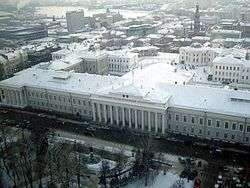 | |
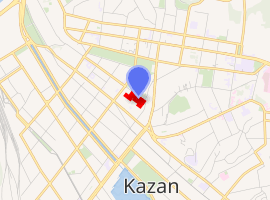
| |
| Colours | Blue and grey |
| Website | eng.kpfu.ru |
Founded in 1804 as Imperial Kazan University, famous mathematician Nikolai Ivanovich Lobachevsky served there as the rector from 1827 until 1846. In 1925, the university was renamed in honour of its most famous student Vladimir Ilyich Ulyanov (Lenin). The university is known as the birthplace of organic chemistry due to works by Aleksandr Butlerov, Vladimir Markovnikov, Aleksandr Arbuzov, and the birthplace of electron spin resonance discovered by Evgeny Zavoisky.
In 2010, Kazan University received a federal status. It is also one of 15 Russian universities that were initially selected to participate in the Project 5-100, coordinated by the Government of the Russian Federation and aimed to improve their international competitiveness among the world’s leading research and educational centers.[2]
As of January 2020, the university comprises 18 primary educational units, 2 of which are territorial branches.[3] More than 50,000 students are enrolled in over 600 degree programs at undergraduate and postgraduate level (including doctoral and double-degree programs with partner universities); the number of international students is about 9,700 from 106 countries.[4]
Research priority areas are concentrated on biomedicine and pharmaceutics, oil extraction, oil refining and petrochemistry, communications and aerospace technologies, advanced materials, and social sciences and humanities.[5]
History
Among the subjects of special pride are the creation of non-Euclidean geometry by Nikolai Lobachevsky, the discovery of the chemical element Ruthenium by Karl Klauss, the theory of chemical structure of organic compounds by Aleksandr Butlerov, the discovery of electron paramagnetic resonance by Yevgeny Zavoisky and acoustic paramagnetic resonance by Semen Altshuler, the development of organophosphorus chemical compounds by Alexander and Boris Arbuzovs and many others.
Since its inception, the university has prepared more than 70 thousand professionals. Among the university students and alumni there are outstanding scholars and famous people such as the founder of the Soviet Union Vladimir Lenin, writers Sergei Aksakov, Leo Tolstoy, Pavel Melnikov-Pechersky, Velimir Khlebnikov, composer Mily Balakirev, and painter Valery Yakobi.
Imperial period
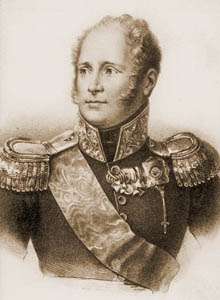
Kazan University, one of the oldest universities in Russia, was founded on November 17, 1804, when Emperor Alexander I signed the Affirmative Letter and the Charter about the creation of the Kazan Imperial University. The first students, enrolled in 1805, were graduates of the First Kazan Gymnasium – an autonomous affiliate of Moscow State University, under whose auspices Kazan University first operated.
It was not until 1814 that the university underwent its full opening. It was restructured as a classical university comprising four departments: moral and political sciences, physical and mathematical sciences, medical sciences and philology. Before Tomsk University was founded, the University of Kazan used to be the easternmost university in the Russian Empire, it was thus serving for Volga, Kama, and Ural regions, Siberia and the Caucasus.
In 1819, M. L. Magnitsky conducted a review of the university, in which he reported on 'the spirit of dissent and irreligion' that he had observed at the university. In his report to the Emperor, he spoke of the "public destruction" of the university and demanded it be closed, but Alexander I put the resolved 'why destroy what can be corrected'. Magnitsky was consequently appointed trustee of the Kazan school district, an action that negatively affected the university, with many professors being dismissed and 'harmful' books withdrawn from the library's collection. In addition, a strict barrack domestic regime was introduced for students of the university.
In 1819–1821 an alumnus and scholar of Kazan University Ivan Simonov participated in the discovery of Antarctica during the first round-the-world expedition and pioneered Antarctic studies.
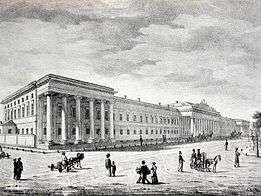
In 1825, the Main Building of the university was built and, in 1830, the Main Campus was completed. This included the Library Building, Chemical Laboratory, dissection facilities, astronomical observatory, and clinics (in the organisation of which contemporaries noted the leading role of Professor Franz Yellachich). Resultantly the university became a leading centre of education and science. It was the scientific faculties that were, at this time, organised into a number of research schools: mathematical, chemical, medical, geological.
Since the first half of the 19th century Kazan University has been the largest center of Oriental Studies in Europe and the birthplace of the world-famous Kazan Linguistic School founded by Jan Baudouin de Courtenay.
Just four years later, in 1834, the journal Proceedings of Kazan University began to be published by academicians of the university and in 1835 Nicholas I ordered to establish three faculties: Philosophical (which was further subdivided into verbal and physical-mathematical departments), Faculty of Law and Faculty of Medicine.
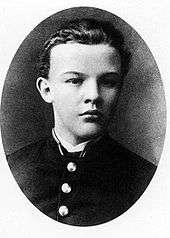
In 1844, Karl Klaus, a professor at the university, discovered, and named in honour of Russia, Ruthenium, the only chemical element discovered in Tsarist Russia. Six years thereafter St. Petersburg University opened the Institute of Oriental Studies and all training materials and collections of Kazan University in this field were transferred to the capital of Imperial Russia. Shortly after that, there was a further reform of the university's structure, when in 1863, by the order of Alexander II, the university was reorganised into four departments: History and Philology, Physics and Mathematics, Law, and Medicine. A renowned linguistic school was forming at the university during 1875–1883.
Around that time Vladimir Ilyich Ulyanov (Lenin), a future leader of the Soviet Union, studied law at the university from August 1887 until his expulsion due to 'student disturbances' in December 1887.[6]
The university faced one of its greatest challenges during the Russian Civil War, when in August–September 1918 the siege and ultimate capture of Kazan by the Red Army and Czechoslovak Corps led to a large exodus of students and faculty members from the city. Subsequently, many of them were enrolled in state universities in Siberia and help they provided proved instrumental in the foundation of universities in Tomsk and Irkutsk.
Kazan Higher Women's Courses
Though approval was given in the Imperial period for Women to audit university lectures from 1859,[7] the Higher Courses were not state funded and required local support, carrying high tuition fees. When petitioned by the university to create courses for women, Dmitry Tolstoy suggested that a curriculum modeled on the Guerrier Courses might be acceptable, though he continuously blocked their implementation in Kazan.[8] In 1876, the imperial government, hoping to secure more qualified teachers, authorized creation of Higher Women's Courses in all cities in the empire which had a university.[9] From October 1876, female applicants who had completed a girls' gymnasium;[8] were certified instructors in arithmetic, history and Russian language;[10] or passed an entrance examination could enroll in evening classes at Kazan University. Those who did not meet those requirements could attend as external auditors, but were excluded from course examinations. Students took six mandatory courses in art history, physics, Russian history and literature, and world history and literature. Optional courses included hygiene, languages, and mathematics.[8]
In 1879, the founder of the Kazan Higher Women's Courses, N. V. Sorokin, expanded the offerings to include two specializations: "historical-philological and physico-mathematical". This opened up additional course offerings including algebra and geometry, chemistry, English language, German literature, geography, history of philosophy, history of physical and mathematical sciences, history of physics, and natural sciences. In 1881, aesthetics was added and in 1884, Latin began being offered as an elective class.[10] The courses allowed women to access higher education for a decade before being permanently closed in 1886.[8] In 1904, professors of the university formed a committee to reinstate the women's courses, but the plan was rejected because of it was economically not feasible. The plan was refused again in 1905, but in 1906, after the Revolution, authorities allowed the university to reinstate the Higher Women's Courses of the historical-philological department.[10] The first Latvian to earn a degree in Folkloric Studies, Anna Bērzkalne, graduated as a Candidate of Philology from the Kazan Higher Women's Courses in 1917.[11][12]
Soviet period
In accordance with a directive from the Council of People's Commissars issued on October 9, 1918, the system of academic ranks was abolished and all university-level lecturers with at least three years of teaching experience were qualifying for the title of professor. This allowed the University of Kazan, which had lost the vast majority of its academic staff during the turmoil of the civil war, to restart proper education and research.
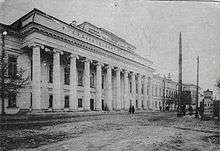
The university soon opened a 'workers' faculty (fifth in the RSFSR), which aimed to provide the education for peasants. On 1 November 1919 peasant workers started their first classes without the requirement to pass an entrance exam. In 1922 the University's Faculty of Forestry merged with the Faculty of Agriculture of Kazan Polytechnic university to form Kazan Institute of Agriculture and Forestry.
In 1925 by the decision of All-Russian Central Executive Committee Kazan State University was renamed to the V. I. Ulyanov-Lenin Kazan State University.[13] This was done in order to recognise the period of time Vladimir Lenin spent as a student at the University of Kazan.
In the 1930s the university continued to evolve with a number of its faculties being separated from it in order to become independent institutions of higher education. Some of them continue their existence, for instance Kazan State Medical University. Moreover, during the World War II years (1941–1943) a number of members of the Soviet Academy of Sciences were evacuated from Moscow and Leningrad and housed under the premises of the university; this, in turn, led to the foundation of Kazan Department of the Academy in 1945.
In the post-war years the University of Kazan underwent a period of rapid expansion and development of its academic base. To recognize the hard work in providing education to the peoples of the Soviet Union Kazan State University was awarded the Order of the Red Banner of Labour in 1953 and later, in 1979, the Order of Lenin. In the 1970s the University's two distinctive high-rise academic buildings were built – the Department of Physics in 1973 and Faculty of Mathematics in 1978. The final major Soviet-era change to the university came with the opening of UNICS Sports Center and Concert Hall in 1989.
21st century
On October 21, 2009, Russian President Dmitry Medvedev signed a presidential decree that established a new Volga Federal University on the basis of Kazan State University.[14][15] The federal university project is realized on the basis of Kazan State University, with the accession of the Tatar State University of Humanities and Education (TGGPU), Kazan State Finance and Economics Institute (KGFEI),[16] Elabuga State Pedagogical University and Naberezhnye Chelny Academy of Engineering and Economy. The university's first rector is Ilshat Gafurov, formerly the mayor of Elabuga.[17][18] The current president is Myakzyum Salakhov.
In 2013 Kazan Federal University launched the Programme for enhancing its competitive ranking among leading world centres of higher education and research (2013–2020) in the framework of implementation of the Government Resolution № 211 «On measures of federal support for the leading universities of the Russian Federation in order to enhance their competitiveness among the leading world scientific and educational centers» (signed on 16 March 2013).
Rankings and reputation
| University rankings | |
|---|---|
| Global – Overall | |
| ARWU World[19] | 801-900 |
| THE World[20] | 601-800 |
| USNWR Global[21] | 783 |
| QS World[22] | 392 |
| National – Overall | |
| Interfax National[23] | 9 |
After having obtained the status of a federal university, KFU tasked itself with advancing in the global rankings race. This is also the primary metric for the participants of the Project 5-100, a national initiative to boost the competitiveness of the top Russian universities, which Kazan University joined in 2013.[24]
The university has been ranked by QS World University Rankings since 2012, steadily climbing from 601+ to 392nd place.[25] It also has 4 stars in QS Stars Ratings, along with another institution from Tatarstan, Kazan National Research Technical University named after A.N.Tupolev.[26]
It’s currently ranked 601 – 800 by Times Higher Education. It’s also in the 201-300 bracket in University Impact and Good health and well-being rankings by the same organization.[27] KFU first appeared in Academic Ranking of World Universities in 2018 and was ranked 801 – 900 in that year and in 2019.
The university is present in 10 subject areas in QS subject rankings and in 7 areas in Times Higher Education rankings. The most notable achievement is 94th place in THE subject rankings for Education in 2019.[28]
In Russian national rankings, Kazan University has been consistently ranked among the best, including 16th place in RAEX rankings and 9th place in Interfax National Ranking of Universities.
Campus
Kazan Federal University’s Main Campus is located in downtown Kazan, 10 minutes away from the Kazan Kremlin.
The Main Building of Kazan University was designed by architect Petr Pyatnitsky and built in the 1820s. The oldest part of the today’s Main Building includes three classic portals along with the white foreside of the original 1822 construction.
From 1832 to 1841, architect M. Korinfsky designed the rest of the buildings comprising the neo-classical Architectural Complex of Kazan University. The Main Building Yard now contains the central administrative offices, the Anatomical Theatre, the Library, chemistry and physics laboratories, and the Observatory.
Chemical Faculty Building (since 2003: Alexander Butlerov Chemistry Institute) was built in 1953 with the support of students. The original building was built in the Soviet neoclassical style. In 1960-70s, two high-rise academic buildings were erected to the north and to the west of the Main Building. The most recent addition was in 2015, when a 7-storey laboratory building was added to the campus.
By President Boris Yeltsin’s Decree in 1996 the Architectural Complex of Kazan University was added to the National Cultural Heritage Register of Russia. During the preparations for 200th anniversary of KFU the East Wing was added to the Main Building and today along with the university administration, the Museum of History of Kazan University, Yevgeny Zavoisky Lab-Museum, the Botanical Museum, Edward Eversman Zoology Museum, and two academic units – the Institute of Fundamental Medicine and Biology together with the Faculty of Law reside there. University sport facilities include UNICS and Bustan Sports Centers built in 1989 and 2010.
KFU is one of just few educational institutions in Russia which offers modern comfortable housing to all students outside of Kazan. KFU dormitory campus is located in the Universiade Village built to accommodate participants of the XXVII World Summer Universiade 2013. It is a residential micro-district for about 12,000 people with a medical center, drugstore, sports equipment rent station, copy center, laundry, beauty salon, cafeteria and other facilities available. The Village project was awarded a diploma "For a special contribution to a socially significant infrastructure creation for youth and sport development" at the world contest FIABCI Prix D’Excellence.
Altogether the premises of Kazan University are located throughout Russia in Tatarstan, Karachay-Cherkessia, Karelia, Mari El and Samara region (Tolyatti).
- Buildings of the Kazan State University
- KFU 2nd Building and Tatar State Library
 Institute of Physics
Institute of Physics Main Campus of the university
Main Campus of the university Alexander Butlerov Institute of Chemistry
Alexander Butlerov Institute of Chemistry- UNICS Sports Center and Concert Hall
- Kazan University Observatory
Organization
The Main Campus of Kazan Federal University located in Kazan is divided into 16 institutes, 3 Higher Schools and two faculties. The university also has two branches in Naberezhnye Chelny and Yelabuga.
The university offers the majority of its programs in Russian. Prospective students who do not speak Russian are required to participate in a one-year language training course at KFU International Preparatory School. Teaching in English is provided for several programs throughout the university at Specialist and Master levels.
Physics, Mathematics and IT
- Institute of Physics
- N.I. Lobachevsky Institute of Mathematics and Mechanics
- Institute of Computational Mathematics and Information Technologies
- Higher School of Information Technologies and Intelligent Systems
- Institute of Engineering
Natural Sciences
- Institute of Geology and Petroleum Technologies
- Institute of Fundamental Medicine and Biology
- Institute of Environmental Sciences
- Alexander Butlerov Institute of Chemistry
Humanities
- Institute of Philology and Intercultural Communication
- Institute of Social and Philosophical Sciences and Mass Communications
- Institute of International Relations
- Institute of Psychology and Education
- Faculty of Law
Economics
- Institute of Management, Economics and Finance
- Higher School of Public Administration
- Higher School of Business
There are also several independent academic units which do not award higher education degrees, such as the Department of Physical Education and Sports, the Faculty of Advanced Training and Staff Retraining, and some others.
Global cooperation
The very foundation of Kazan University was directly linked to international academia. Some of the University's first teachers were German professors such as Johann Bartels, Franz Erdman and Christian Fren. The famous German professor Karl Fuchs, who was both the founder of Kazan Medical School and the first European researcher of Tatar history and culture, became the University's rector in the 1820s and was awarded the title of Honourable Citizen of Kazan.
KFU has partner agreements[29] with approximately 190 universities and research centres from more than 53 countries all over the world. Thanks to its fruitful cooperation with the long-term partners such as Justus-Liebig University of Giessen (Germany), the Superior Institute of Materials and Advance Mechanics (ISMANS, France), Research Institute RIKEN (Japan) and many others, KFU has taken advantage of participating in various research programmes and implementing double diploma programs and cotutelle agreements.
Currently (2015–2016 academic year), about 3000 international students[30] are studying in KFU on different academic programmes.[31]
Each year, more than 900 students and faculty members of KFU visit foreign universities and research centres for various purposes, including international conferences. About 1500 specialists from abroad are involved in various scientific events, development and introduction of new courses, research collaboration and other international activity[29] at KFU. Many native speaking specialists teach Chinese, Korean, Farsi, German, Spanish, English and other foreign languages on a regular basis at KFU. Among the honorary doctors and professors of KFU[32] there are Vladimir Minkin, Alexei Starobinsky, Ichak Kalderon Adizes, Rashid Sunyaev, Anatole Abragam, Karl Alexander Müller, Brebis Bleaney, Ryoji Noyori, Mikhail Piotrovsky, Vitaly Ginzburg, Marat Yusupov[33] and other famous scientists and Nobel prizers.
Every year KFU academic staff carry out on average 40 joint international projects and get individual support for research and study from DAAD, DFG, Volkswagen Foundation, NSF, European Commission (Tempus, FP7, Marie-Curie Actions, Erasmus-Mundus, etc.) and other grant making organizations.
KFU carry out several big projects on Mega-grants received from the Russian Government in the framework of Resolution No.220 of the Government of the Russian Federation "On measures designed to attract the world’s leading scientists to Russian institutions of higher learning, research organizations of the governmental academies of sciences, and governmental research centers of the Russian Federation" and Resolution No 218 of the Government of the Russian Federation "On promoting cooperation between higher educational institutions and organizations implementing comprehensive high-technology production":
- International research laboratory "Neurobiology. Early activity in the developing brain"[34] supervised by prof. Rustem Khazipov. The project is implemented jointly with the Institut national de la sante et de la recherche medicale (INSERM)[35] (France);
- Joint project of KFU and «Nizhnekamskneftekhim»:[36] "Increasing effectiveness for obtaining monomers of synthetic rubber by development and distribution of advanced catalysts of isoamylene dehydration".
- Joint project of KFU and TNG Group:[37] «Development of innovative technologies and industrial management of equipment and software for effective investigation of resources for the purpose of identification of hydrocarbon deposits and supervision of their development».
- Joint project of KFU and "Tasma" Co.:[38] "Development and Production of competitive photorecording materials".
Starting from 2011 Kazan University implements a large-scale project "Pharma 2020" financed within Federal Target Program of Russian Federation "Development of pharmaceutical and medical industry till 2020 and following perspectives" (Pharma-2020). Research and Education Center of Pharmaceutics was established providing interdisciplinary research for development and production of innovative drugs.
The University administration and faculty have paid special attention to the European Tempus and Erasmus scheme for cooperation, with over a dozen large-scale projects which have been successfully implemented during the last 20 years. Today KFU students and academic staff enjoy wonderful opportunities of training at best European universities as part of both "Integration, Interaction and Institutions (Triple I)"[39] and "Aurora"[40] projects (Erasmus Mundus program[41]). These projects often reach beyond the University, making it a centre of entirely new regional research and educational networks involved in international collaboration.
Library
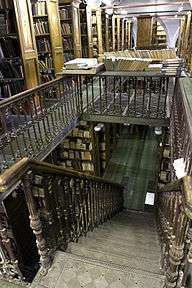
Kazan University Nikolai Lobachevsky Scientific Library has one of the world's most important bibliographical collections, including 15,000 manuscripts and 3,000 rare books. Opened in 1809, it first contained Count G. Potemkin's books brought to Kazan in 1799 mixed with collections of the earliest bibliophiles V. Polyansky and N. Bulich. Subsequently, the collections of Solovetsky Monastery were added to the library.
These original books remain and are kept in the special depository of the library. In this special collection are Arabic manuscripts of philosophers and scholars Mansur Al-Hallaj and Avicenna (11th century) and Ashshakhrestani (12th century), a manuscript copy of the Pentateuch, the first Russian printed book "The Apostle" (1564), the "Books of Kingdoms" by Francisco Skorin (1518) and the "Code of Tsar Alexis Mikhailovich" (1649). The Library has first editions of the 18th-century books by Pushkin, Griboyedov, Gogol, Nasíri and Tuqay.
The library contains many 19th-century periodicals, and literature about Kazan and the surrounding region. The library boasts itself as "the pride of the University and an invaluable source of information for any researcher." The original library building was built between 1825 and 1833 by Rector N. Lobachevsky, who was at the same time the chief librarian of the university. The library, which now bears his name, is still growing, and even its new building cannot house all the collections. Kazan University also has many museums.
Notable faculty and alumni
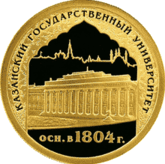
Politics
Sergey Aksakov, Vladmir Ulyanov (Vladimir Lenin) (expelled), Alexei Rykov, Xösäyen Yamaşev, Sergei Bakinsky, Vasili Osipanov, Nikolai Semashko, Dmitry Karakozov, Nikolay Fyodorov.
Mathematics and sciences
Aleksandr Arbuzov, Nikolai Chebotaryov, Aleksandr Butlerov, Naum Meiman, Kimal Akishev, Nikolay Lobachevski, Ivan Simonov, Vladimir Markovnikov, Konstantin Mereschkowski, Nikolay Beketov, Nikolay Zinin, Alexander Zaytsev, Sergey Reformatsky, Alexander Vishnevsky, Liverij Darkshevich, Platon Poretsky, Nikolai Brashman, Karl Ernst Claus, Joseph Johann Littrow, Johann Bartels, Adolph Theodor Kupffer, Marian Kowalski, Aleksandr Kotelnikov, Mikhail Lavrentyev, Yevgeny Zavoisky, Roald Sagdeev, Vladimir Engelgardt, Alexander Luria, Dmitry Dubyago, Alexander Dubyago, Georgii Frederiks, Semen Altshuler, Mikhail Lyapunov, Dmitrii Sintsov, Oskar Anderson, Wilhelm Anderson, Vladimir Galkin, Kadir Timergazin, Vladimir Moskovkin, Emmanuel Rashba.
Music and art
Mily Balakirev, Stanislav Govorukhin, Ilya Ulyanov, Stepan Smolensky, Karl Fuchs, Michael Minsky (Spirin), Yuliya Zaripova, Oleg Saitov.
Literature
Pavel Melnikov-Pechersky, Velimir Khlebnikov, Pyotr Boborykin, Eugenia Ginzburg, Leo Tolstoy, Daniil Mordovtsev, Alexander Tarasov-Rodionov.
Education
Jan Niecisław Baudouin de Courtenay, Vladimir Bekhterev, Mikołaj Kruszewski, Ivan Yakovlev, Vladimir Burtsev, Peter Lesgaft, Sergey Malov, Nikolay Ilminsky, Afanasy Shchapov, Christian Martin Frähn, Alexander Kazembek, Nicolai A. Vasiliev, Vasily Vasilyev, Józef Kowalewski, Nikolay Likhachyov, Nikolay Neprimerov, Vasili Razumovsky, Walter Anderson (folklorist), Valentin A. Bazhanov.
See also
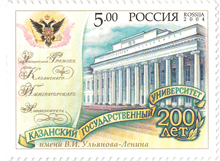
- Education in Russia
- List of modern universities in Europe (1801–1945)
- List of Kazan State University's rectors
- List of universities in Russia
References
- 5 November 1804 (O.S.)
- "The university-participants in the Project 5-100 present their roadmaps". Проект 5-100: Российское образование мирового класса!. Retrieved 2020-01-17.
- "Academic Units - Kazan (Volga region) Federal University". kpfu.ru. Retrieved 2020-01-17.
- "Facts, Figures, Rankings\About the University - Kazan (Volga region) Federal University". kpfu.ru. Retrieved 2020-01-17.
- "Priority areas\Research and Innovations - Kazan (Volga region) Federal University". kpfu.ru. Retrieved 2020-01-17.
- Lenin.'An Unfinished Autobiography,' 1917. Collected Works, Vol. 41. (Moscow: Progress, 1977.p 430)
- Engel, Barbara Alpern (2004). Women in Russia, 1700-2000. Cambridge, UK: Cambridge University Press. p. xvii. ISBN 978-0-521-00318-6.
- Johanson, Christine (1987). Women's Struggle for Higher Education in Russia, 1855-1900. Montreal, Quebec: McGill–Queen's University Press. pp. 63–66. ISBN 978-0-7735-6115-1.
- Dudgeon, Ruth A. (1982). "The Forgotten Minority: Women Students in Imperial Russia, 1872-1917". Russian History. Leiden, Netherlands: Brill Publishers for the Russian Academy of Sciences. 9 (1): 1–26. doi:10.1163/187633182X00010. ISSN 0094-288X. JSTOR 24652820.
- Kornilova, Irina V.; Magsumov, Timur A. (2017). "Emancipation in Educational System: Formation of Women's Higher Education in Russia" (PDF). European Journal of Contemporary Education. Bratislava, Slovakia: Academic Publishing House Researcher. 6 (2): 352–366. doi:10.13187/ejced.2017.2.352. ISSN 2304-9650. Retrieved 4 March 2020.
- Ķencis, Toms (2012). A Disciplinary History of Latvian Mythology (PhD). Tartu, Estonia: University of Tartu Press. p. 80. ISBN 978-9949-32-112-4.
- "Anna Bērzkalne: Īsa biogrāfija" [Anna Bērzkalne: Short Biography]. Latviešu folkloras krātuve (in Latvian). Riga, Latvia: Archive of Latvian Folklore. 2001. Archived from the original on 4 March 2016. Retrieved 4 March 2020.
- Regulations of the Kazan State University «Устав государственного образовательного учреждения высшего профессионального образования "Казанский государственный университет им. В.И.Ульянова-Ленина»
- Prime Minister Vladimir Putin signs a series of executive orders granting federal state autonomous university status to several Russian universities Archived 2011-07-24 at the Wayback Machine
- Президент подписал Указ «О создании федеральных университетов в Северо-Западном, Приволжском, Уральском и Дальневосточном федеральных округах»
- Volga Federal University can join KSU, KGFEI, TGGPU and KGASU Archived 2012-03-18 at the Wayback Machine
- Распоряжение от 9 апреля 2010 г. №513-р Archived 2011-07-24 at the Wayback Machine
- TatCenter.ru. (April 8, 2010) У Казанского (Приволжского) федерального университета новый ректор
- Academic Ranking of World Universities 2017
- "World University Rankings". 19 September 2018.
- "Archived copy". Archived from the original on 2014-10-28. Retrieved 2020-01-16.CS1 maint: archived copy as title (link)
- "Top Universities".
- "Сводный рейтинг выборки университетов России". Archived from the original on 2015-06-07. Retrieved 2020-01-16.
- "More info". www.5top100.ru. Retrieved 2020-01-16.
- "Kazan (Volga region) Federal University". Top Universities. 2015-07-16. Retrieved 2020-01-16.
- "QS Stars University Ratings". Top Universities. 2014-05-08. Retrieved 2020-01-17.
- "Kazan Federal University". Times Higher Education (THE). 2019-09-09. Retrieved 2020-01-16.
- "World University Rankings 2020 by subject: education". Times Higher Education (THE). 2019-10-29. Retrieved 2020-01-16.
- Kazan University at a Glance // Official site of Kazan (Volga region) Federal University
- International students in KFU
- Academic programmes // Official site of Kazan (Volga region) Federal University
- KFU Honorary Doctors and Professors // Official site of Kazan (Volga region) Federal University
- Integrated structural Biology
- International research laboratory // Official site of Kazan (Volga region) Federal University
- Inserm – French National Institute of Health and Medical Research
- Joint project of KFU and «Nizhnekamskneftekhim» // Official site of Kazan (Volga region) Federal University
- Joint project of KFU and TNG Group // Official site of Kazan (Volga region) Federal University
- Joint project of KFU and "Tasma" Co. // Official site of Kazan (Volga region) Federal University
- "Integration, Interaction and Institutions (Triple I)" // Official site of Turun yliopisto University of Turku Archived 2015-05-18 at the Wayback Machine
- Aurora Project // Official site of Turun yliopisto University of Turku
- "Education, Audiovisual and Culture Executive Agency". Archived from the original on 2010-05-29. Retrieved 2010-05-29.
Further reading
- Smith-Peter, Susan. (2016), "Enlightenment from the East: Early Nineteenth Century Russian Views of the East from Kazan University", Znanie. Ponimanie. Umenie, 13 (1): 318–338, doi:10.17805/zpu.2016.1.29, archived from the original on 8 July 2019, retrieved 5 May 2016.
External links
| Wikimedia Commons has media related to Kazan University. |
